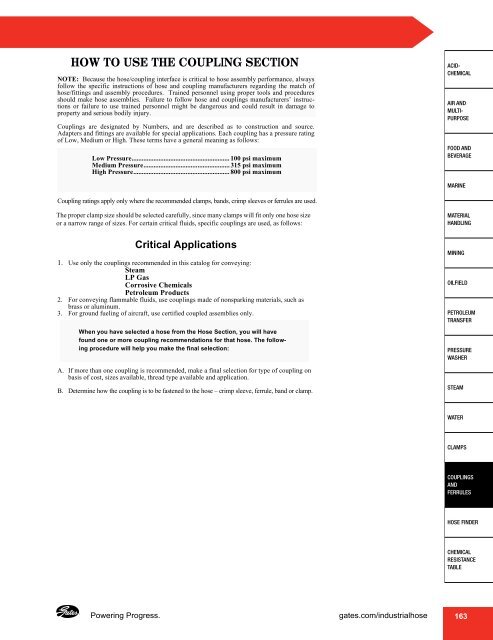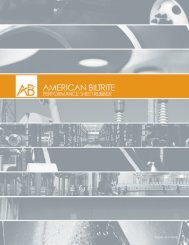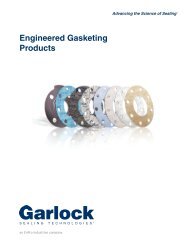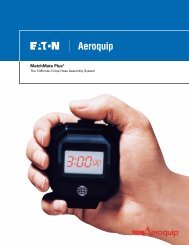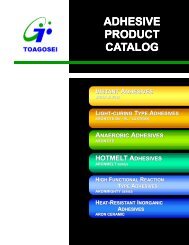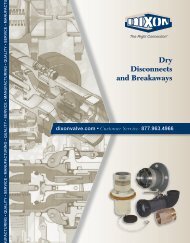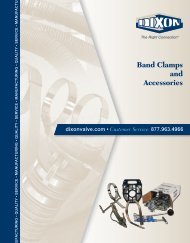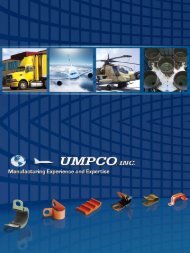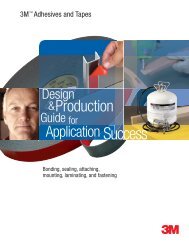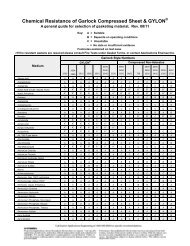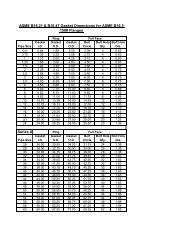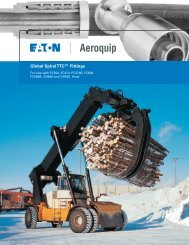- Page 1 and 2:
HOSE, COUPLINGS + EQUIPMENT2012 IND
- Page 3 and 4:
GATES INDUSTRIAL HOSE PRODUCTSCANCE
- Page 5 and 6:
GATES INDUSTRIAL HOSE PRODUCTSTERMS
- Page 7 and 8:
GATES INDUSTRIAL HOSE PRODUCTSStain
- Page 9 and 10:
GATES INDUSTRIAL HOSE PRODUCTSSubje
- Page 11 and 12:
GATES INDUSTRIAL HOSE PRODUCTSCUT L
- Page 13 and 14:
GATES INDUSTRIAL HOSE PRODUCTSCUT L
- Page 15 and 16:
GATES INDUSTRIAL HOSE PRODUCTSSELEC
- Page 17 and 18:
GATES INDUSTRIAL HOSE PRODUCTSAppli
- Page 19 and 20:
GATES INDUSTRIAL HOSE PRODUCTS1. Ha
- Page 21 and 22:
GATES INDUSTRIAL HOSE PRODUCTSHose
- Page 23 and 24:
GATES INDUSTRIAL HOSE PRODUCTSGATES
- Page 25 and 26:
GATES INDUSTRIAL HOSE PRODUCTSGATES
- Page 27 and 28:
GATES INDUSTRIAL HOSE PRODUCTSACID-
- Page 29 and 30:
GATES INDUSTRIAL HOSE PRODUCTSACID-
- Page 31 and 32:
GATES INDUSTRIAL HOSE PRODUCTSACID-
- Page 35 and 36:
GATES INDUSTRIAL HOSE PRODUCTSACID-
- Page 37 and 38:
GATES INDUSTRIAL HOSE PRODUCTSACID-
- Page 39 and 40:
GATES INDUSTRIAL HOSE PRODUCTSACID-
- Page 41 and 42:
GATES INDUSTRIAL HOSE PRODUCTSACID-
- Page 43 and 44:
GATES INDUSTRIAL HOSE PRODUCTSACID-
- Page 45 and 46:
GATES INDUSTRIAL HOSE PRODUCTSACID-
- Page 47 and 48:
GATES INDUSTRIAL HOSE PRODUCTSACID-
- Page 49 and 50:
GATES INDUSTRIAL HOSE PRODUCTSACID-
- Page 51 and 52:
GATES INDUSTRIAL HOSE PRODUCTSACID-
- Page 53 and 54:
GATES INDUSTRIAL HOSE PRODUCTSACID-
- Page 55 and 56:
GATES INDUSTRIAL HOSE PRODUCTSACID-
- Page 57 and 58:
GATES INDUSTRIAL HOSE PRODUCTSACID-
- Page 59 and 60:
GATES INDUSTRIAL HOSE PRODUCTSACID-
- Page 61 and 62:
GATES INDUSTRIAL HOSE PRODUCTSACID-
- Page 63 and 64:
GATES INDUSTRIAL HOSE PRODUCTSACID-
- Page 65 and 66:
GATES INDUSTRIAL HOSE PRODUCTSACID-
- Page 67 and 68:
GATES INDUSTRIAL HOSE PRODUCTSACID-
- Page 69 and 70:
GATES INDUSTRIAL HOSE PRODUCTSACID-
- Page 71 and 72:
GATES INDUSTRIAL HOSE PRODUCTSACID-
- Page 73 and 74:
GATES INDUSTRIAL HOSE PRODUCTSACID-
- Page 75 and 76:
GATES INDUSTRIAL HOSE PRODUCTSACID-
- Page 77 and 78:
GATES INDUSTRIAL HOSE PRODUCTSACID-
- Page 79 and 80:
GATES INDUSTRIAL HOSE PRODUCTSACID-
- Page 81 and 82:
GATES INDUSTRIAL HOSE PRODUCTSACID-
- Page 83 and 84:
GATES INDUSTRIAL HOSE PRODUCTSACID-
- Page 85 and 86:
GATES INDUSTRIAL HOSE PRODUCTSACID-
- Page 87 and 88:
GATES INDUSTRIAL HOSE PRODUCTSACID-
- Page 89 and 90:
GATES INDUSTRIAL HOSE PRODUCTSACID-
- Page 91 and 92:
GATES INDUSTRIAL HOSE PRODUCTSACID-
- Page 93 and 94:
GATES INDUSTRIAL HOSE PRODUCTSACID-
- Page 95 and 96:
GATES INDUSTRIAL HOSE PRODUCTSACID-
- Page 97 and 98:
GATES INDUSTRIAL HOSE PRODUCTSACID-
- Page 99 and 100:
GATES INDUSTRIAL HOSE PRODUCTSACID-
- Page 101 and 102:
GATES INDUSTRIAL HOSE PRODUCTSACID-
- Page 103 and 104:
GATES INDUSTRIAL HOSE PRODUCTSACID-
- Page 105 and 106:
GATES INDUSTRIAL HOSE PRODUCTSACID-
- Page 107 and 108:
GATES INDUSTRIAL HOSE PRODUCTSACID-
- Page 109 and 110:
GATES INDUSTRIAL HOSE PRODUCTSACID-
- Page 111 and 112:
GATES INDUSTRIAL HOSE PRODUCTSACID-
- Page 113 and 114: GATES INDUSTRIAL HOSE PRODUCTSACID-
- Page 115 and 116: GATES INDUSTRIAL HOSE PRODUCTSACID-
- Page 117 and 118: GATES INDUSTRIAL HOSE PRODUCTSACID-
- Page 119 and 120: GATES INDUSTRIAL HOSE PRODUCTSACID-
- Page 121 and 122: GATES INDUSTRIAL HOSE PRODUCTSACID-
- Page 123 and 124: GATES INDUSTRIAL HOSE PRODUCTSACID-
- Page 125 and 126: GATES INDUSTRIAL HOSE PRODUCTSACID-
- Page 127 and 128: GATES INDUSTRIAL HOSE PRODUCTSACID-
- Page 129 and 130: GATES INDUSTRIAL HOSE PRODUCTSACID-
- Page 131 and 132: GATES INDUSTRIAL HOSE PRODUCTSACID-
- Page 133 and 134: GATES INDUSTRIAL HOSE PRODUCTSACID-
- Page 135 and 136: GATES INDUSTRIAL HOSE PRODUCTSACID-
- Page 137 and 138: GATES INDUSTRIAL HOSE PRODUCTSHigh
- Page 139 and 140: GATES INDUSTRIAL HOSE PRODUCTSHigh
- Page 141 and 142: GATES INDUSTRIAL HOSE PRODUCTSACID-
- Page 143 and 144: GATES INDUSTRIAL HOSE PRODUCTSACID-
- Page 145 and 146: GATES INDUSTRIAL HOSE PRODUCTSACID-
- Page 147 and 148: GATES INDUSTRIAL HOSE PRODUCTSACID-
- Page 149 and 150: GATES INDUSTRIAL HOSE PRODUCTSACID-
- Page 151 and 152: GATES INDUSTRIAL HOSE PRODUCTSACID-
- Page 153 and 154: GATES INDUSTRIAL HOSE PRODUCTSACID-
- Page 155 and 156: GATES INDUSTRIAL HOSE PRODUCTSACID-
- Page 157 and 158: GATES INDUSTRIAL HOSE PRODUCTSACID-
- Page 159 and 160: GATES INDUSTRIAL HOSE PRODUCTSACID-
- Page 161 and 162: GATES INDUSTRIAL HOSE PRODUCTSACID-
- Page 163: GATES INDUSTRIAL HOSE PRODUCTSACID-
- Page 167 and 168: GATES INDUSTRIAL HOSE PRODUCTSACID-
- Page 169 and 170: GATES INDUSTRIAL HOSE PRODUCTSACID-
- Page 171 and 172: GATES INDUSTRIAL HOSE PRODUCTSACID-
- Page 173 and 174: GATES INDUSTRIAL HOSE PRODUCTSACID-
- Page 175 and 176: GATES INDUSTRIAL HOSE PRODUCTSACID-
- Page 177 and 178: GATES INDUSTRIAL HOSE PRODUCTSHose
- Page 179 and 180: GATES INDUSTRIAL HOSE PRODUCTSHose
- Page 181 and 182: GATES INDUSTRIAL HOSE PRODUCTSHose
- Page 183 and 184: GATES INDUSTRIAL HOSE PRODUCTSHose
- Page 185 and 186: GATES INDUSTRIAL HOSE PRODUCTSHose
- Page 187 and 188: GATES INDUSTRIAL HOSE PRODUCTSHose
- Page 189 and 190: GATES INDUSTRIAL HOSE PRODUCTSHose
- Page 191 and 192: GATES INDUSTRIAL HOSE PRODUCTSHose
- Page 193 and 194: GATES INDUSTRIAL HOSE PRODUCTSHose
- Page 195 and 196: GATES INDUSTRIAL HOSE PRODUCTSHose
- Page 197 and 198: GATES INDUSTRIAL HOSE PRODUCTSACID-
- Page 199 and 200: GATES INDUSTRIAL HOSE PRODUCTSACID-
- Page 201 and 202: GATES INDUSTRIAL HOSE PRODUCTSACID-
- Page 203 and 204: GATES INDUSTRIAL HOSE PRODUCTSACID-
- Page 205 and 206: GATES INDUSTRIAL HOSE PRODUCTSACID-
- Page 207 and 208: GATES INDUSTRIAL HOSE PRODUCTSACID-
- Page 209 and 210: GATES INDUSTRIAL HOSE PRODUCTSACID-
- Page 211 and 212: GATES INDUSTRIAL HOSE PRODUCTSACID-
- Page 213 and 214: GATES INDUSTRIAL HOSE PRODUCTSACID-
- Page 215 and 216:
GATES INDUSTRIAL HOSE PRODUCTSACID-
- Page 217 and 218:
GATES INDUSTRIAL HOSE PRODUCTSACID-
- Page 219 and 220:
GATES INDUSTRIAL HOSE PRODUCTSACID-
- Page 221 and 222:
GATES INDUSTRIAL HOSE PRODUCTSACID-
- Page 223 and 224:
GATES INDUSTRIAL HOSE PRODUCTSACID-
- Page 225 and 226:
GATES INDUSTRIAL HOSE PRODUCTSACID-
- Page 227 and 228:
GATES INDUSTRIAL HOSE PRODUCTSACID-
- Page 229:
POWERING PROGRESS GATES CORPORATION


